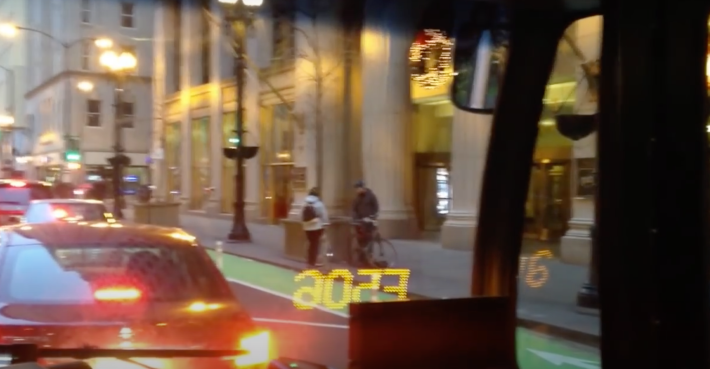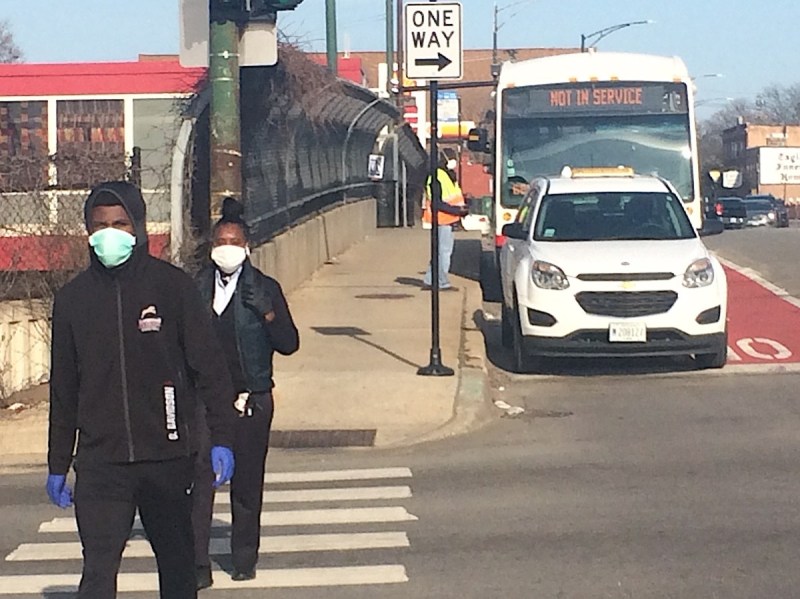Up to now one of the major downsides of Mayor Lori Lightfoot's COVID response has been the failure to implement emergency bus lanes to shorten trip times and reduce the chances of viral exposure for passengers, something peer cities like New York have been doing for months. Back in late May, Chicago Department of Transportation chief Gia Biagi told Crain’s magazine that the city was considering creating new bus lanes, but there has pretty much been radio silence on the subject ever since.
Streetsblog Chicago has highlighted the issue several times since then, as well as Lightfoot's failure to keep campaign promise to build 50 miles of bus lanes. So far only a handful of blocks of new rush hour-only bus lanes have been created during her first 16 months in office.
But there was some good news today: Lightfoot announced that CDOT and the CTA are launching "Pop-Up Essential Bus Lanes" as part of a pilot on two of the city’s highest ridership routes, #79th Street and #66 Chicago Avenue. Together these corridors average a total of almost 20,000 transit riders per day during non-pandemic times. While these streets have already gotten small-scale rush-only-hour treatments, the first phase of the new project will create 7.6 total miles of new bus lanes that will be in effect 24 hours on a pilot basis.
While that might not sound like a lot of miles, it will more than double our city's total busway mileage, which was a pathetic four miles at the end of 2019, compared with New York’s 82.8 and Los Angeles’s 35.4 miles. The temporary CTA lanes will be installed on three miles of 79th, from Cicero to Western, and 4.6 miles of Chicago, from Laramie to Ashland. Chicago and 79th are generally four-lane streets on these stretches, and two of the lanes will be marked as bus lanes with temporary striping and signs.
The bus lanes will help keep car driver-created traffic jams from slowing down transit riders, and prevent bus bunching and unsafe crowding -- if motorists respect them. That's a big if, because, unlike in cities like New York, there's no camera enforcement of bus lanes in Chicago. That would require passing new legislation in Springfield, something Lightfoot promised during the last election that she'd pursue, but hasn't taken any visible action on yet.
Curbside parking and other access will be maintained along the new busways, and right turns across the bus lanes will be permitted at all intersections. Judging from the downtown Loop Link corridor, where right turns by drivers are allowed at several junctions, that policy will undermine the speed advantages of the bus lanes, since Loop Link drivers currently slow to a crawl when approaching right-turn intersections as a precaution to avoid collisions with right-turning drivers.

“CTA buses remain critical and reliable transit resources for those—especially on our city's South and West sides—who do not have the luxury of being able to work from home," said Lightfoot in a statement. "This program is the first step to ensure our residents will continue to have convenient access to public transportation throughout the pandemic and after. I am excited to double down on our investment in our renowned transit system and look forward to increasing the quality of commuting for our essential workers and other residents who ride the bus.”
Construction of the new bus lanes will begin next month, and the pilot is expected to last for at least six months while officials evaluate the impact on bus performance and traffic in general. More bus lines and route segments are being considered for future interventions.
"As Chicago continues on a cautious path to recovery from the COVID-19 pandemic, traffic volumes are slowly climbing toward pre-pandemic levels, which can cause bus delays and bus bunching," the city stated in a press release. "Keeping transit working safely and smoothly is critical to help prevent clogging of streets by private vehicles." Streetsblog was making this argument months ago when traffic was much lighter and there would have been less potential political backlash to repurposing mixed-traffic lanes but, hey, better late than never.






